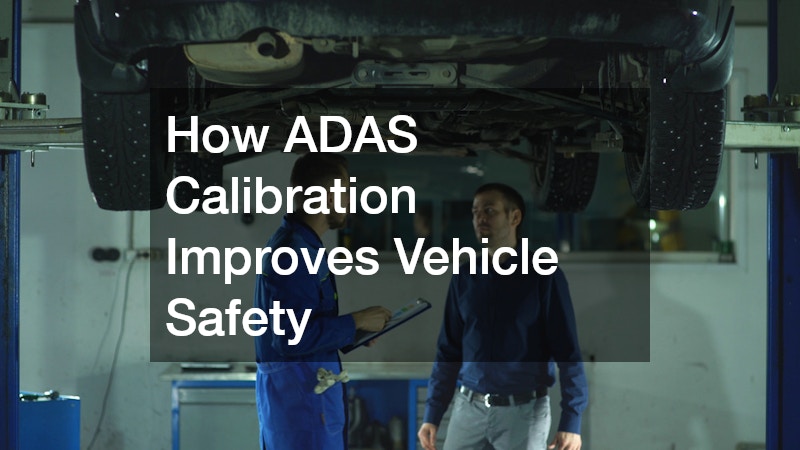
This article explores the significance of Advanced Driver Assistance Systems (ADAS) calibration in enhancing vehicle safety. It discusses common queries regarding ADAS and highlights how proper calibration can lead to safer driving experiences.
What is ADAS Calibration and Why is it Important?
ADAS calibration refers to the process of aligning and configuring the various sensors and cameras in advanced driver assistance systems to ensure they function correctly. These systems play a vital role in modern vehicles, offering safety features such as lane departure warnings, automatic emergency braking, and adaptive cruise control.
Proper calibration is necessary for these features to perform as intended, relying on precise data input from sensors positioned around the vehicle.
The technology underlying ADAS is complex and relies on a network of sensors, cameras, and radar systems that can detect obstacles, lane markings, and other relevant metrics crucial for safety. When any component of the system is altered—whether due to repairs or replacements—it may necessitate recalibration to restore the system’s safety functionality. This preventive measure helps maintain the integrity and reliability of safety features critical for avoiding accidents and improving overall vehicle performance.
Moreover, calibration helps to ensure that all safety systems in the vehicle can communicate effectively with one another. Sensors that are misaligned or misconfigured can lead to erroneous data being interpreted by the vehicle’s control systems, potentially resulting in critical failures during operation. In summary, understanding ADAS calibration and its importance contributes significantly to overall vehicle safety and enhances driver confidence on the road.
How Often Should ADAS Calibration be Performed?
Determining the frequency of ADAS calibration can depend on various factors, including the manufacturer’s guidelines, the vehicle’s usage, and specific changes made to the vehicle. Typically, calibration should be performed whenever there is a significant alteration to the vehicle’s structure or its components, such as after a collision, or if sensors have been damaged or replaced. Regular maintenance checks may catch these incidents before they escalate into serious safety hazards.
In addition to repairs, ADAS calibration may be necessary following software updates or modifications to the vehicle’s electronic systems. Driving conditions can also play a role in influencing how often calibration should be performed, especially in regions with extreme weather or irregular road conditions. Owners should be proactive in keeping their vehicles safe by adhering closely to recommended maintenance schedules provided by manufacturers.
Understanding when to have ADAS calibration performed can directly influence safety outcomes. If drivers are ever uncertain, consulting with professional automotive technicians can provide clarity regarding whether or not a calibration is necessary. Ultimately, neglecting regular checks can lead to vehicle performance issues, thus increasing the need for passengers and drivers to be vigilant about potential signs of malfunction.
What Are the Risks of Not Calibrating ADAS?
Failing to calibrate ADAS can lead to significant safety risks, including increased accident rates and compromised vehicle functionality. When advanced safety features are not aligned correctly, it can result in poor detection of obstacles or other critical factors that the system is designed to mitigate. This misalignment can cause safety features like lane keeping assistance and forward collision warnings to act erratically or fail entirely, posing serious hazards on the road.
Moreover, a lack of calibration can lead to a false sense of security for drivers. When all systems appear to be functioning without visible issues, individuals may overlook the need for calibration, leading to a higher risk of malfunction during critical situations, such as sudden stops or unexpected lane changes. Ignorance concerning calibration can ultimately have dire consequences, jeopardizing the lives of both drivers and passengers.
What is the Calibration Process for ADAS?
The calibration process for ADAS typically begins with a comprehensive diagnostic check of the vehicle’s systems to identify any existing issues before calibration is performed. Technicians utilize specialized equipment to assess the functionality of cameras and sensors, ensuring that they meet the manufacturer’s specifications. This initial assessment is crucial for pinpointing any malfunctioning components that may need replacement prior to the calibration procedure.
Once diagnostics are completed, the vehicle undergoes the actual calibration process, which can vary based on the make and model of the vehicle as well as the technology integrated into it. Common calibration techniques include static calibration, which is performed in a controlled environment, and dynamic calibration, which requires the vehicle to be driven under certain conditions to adjust the systems in real time. Technicians carefully document the calibration process to provide a record for future reference and maintenance checks.
Lastly, after calibration is complete, a final diagnostic check is typically conducted to verify that all systems are functioning correctly. Technicians ensure that various safety features are activated and operating efficiently, thereby confirming that the calibration was successful. This meticulous approach helps to promote long-term safety and reliability, ensuring that drivers can rely on their vehicle’s advanced safety technologies without hesitation.
Understanding and implementing proper ADAS calibration is crucial for enhancing vehicle safety. Regular checks and timely calibration ensure that advanced safety technologies function as intended, ultimately leading to safer roads for everyone. By recognizing the importance of these systems, vehicle owners can contribute positively to road safety and prevent accidents due to misconfigured equipment.
